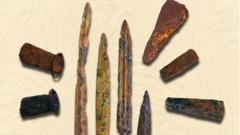In a groundbreaking discovery, archaeologists in Tamil Nadu have revealed what could be some of the world’s oldest evidence of iron technology, pushing back established timelines for the Iron Age. Recent digs at sites such as Adichchanallur, Mayiladumparai, and Kodumanal have unearthed over 5,000-year-old iron objects, indicating that sophisticated iron manufacturing may have developed independently in the Indian subcontinent, challenging prior notions about the origins of iron production.
These excavations uncovered a variety of iron artifacts, including tools and weapons, with some findings featuring intricate craftsmanship such as an ultra-high-carbon steel sword dating to the 13th century BC. This suggests that the ironworking skills of ancient Tamil Nadu were not only sophisticated but exceeded previously known capabilities of other ancient cultures, notably those in the Near East.
While the discovery reignites debates about the beginnings of the Iron Age, experts like Parth R. Chauhan of the Indian Institute of Science Education and Research urge caution in making sweeping conclusions. He posits that iron technology likely appeared independently in multiple regions, indicating that Tamil Nadu’s findings could signify parallel advancements occurring globally.
Furthermore, the ongoing explorations in Tamil Nadu are widely regarded as a crucial chapter in understanding the technological advancements of past civilizations and the significant role they played in shaping regional and global histories. However, experts emphasize that the archaeological landscape in India is still underexplored. While Tamil Nadu's findings are revolutionary, they stress the importance of further archaeological work in other parts of India to expand insights into the origins of iron technology.
In the words of well-respected archaeologist Katragadda Paddayya, this marks only the beginning of a deeper inquiry into iron's historical development. As excavations continue, the possibility of uncovering even older artifacts and further illuminating the advancements of past societies remains a tantalizing prospect.



















